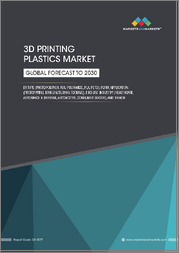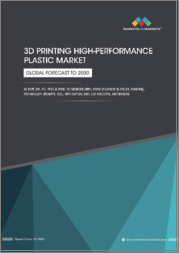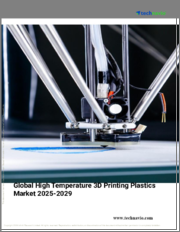
|
시장보고서
상품코드
1800252
3D 프린팅 플라스틱 시장 : 예측(2025-2030년)3D Printing Plastics Market - Forecasts fom 2025 to 2030 |
||||||
3D 프린팅 플라스틱 시장은 CAGR 22.92%로 성장할 전망이며, 2025년 33억 4,900만 달러에서 2030년에는 93억 9,800만 달러로 성장할 것으로 예측됩니다.
세계의 3D 프린팅 플라스틱 시장은 2025-2030년 강력한 성장을 이룰 것으로 예측되고 있으며, 그 원동력이 되고 있는 것은 자동차 산업 및 헬스케어 산업에서 3D 프린팅의 채용 증가이며, 또한 이 기술에 의한 커스터마이즈의 용이함입니다. 폴리유산(PLA), 폴리에틸렌 테레프탈레이트(PET), 아크릴로 니트릴 부타디엔 스티렌(ABS)과 같은 3D 프린팅 플라스틱은 의료용 임플란트에서 자동차 부품에 이르기까지 경량으로 맞춤형 부품을 생산하는 데 필수적입니다. 이 시장은 적층 조형 기술의 진보, 정밀도에 대한 요구 증가, 최종 사용자 용도의 확대에 의해 추진되고 있습니다. 북미와 유럽이 여전히 주요 시장인 반면 아시아태평양은 큰 성장이 예상됩니다. 문제는 높은 재료 비용 및 규제 장애물을 포함합니다.
시장 성장 촉진요인
자동차 및 헬스케어 분야에서의 채용 확대
자동차 및 헬스케어 분야는 3D 프린팅 플라스틱 시장의 주요 촉진요인입니다. 자동차 분야에서 3D 프린팅 플라스틱은 프로토타이핑, 금형 제작, 인테리어 및 구조 부품과 같은 경량 부품의 제조에 사용되어 연비를 향상시키고 제조 비용을 절감합니다. 헬스케어에서 PLA 및 PET와 같은 플라스틱은 맞춤형 임플란트, 인공 장비 및 수술용 가이드의 제조에 채택되어 환자 고유의 정밀 설계로 환자의 예후를 개선합니다. 이러한 용도에 대한 수요 증가는 산업계가 효율성 및 개별화를 우선하게 되어 시장 확대의 원동력이 되고 있습니다.
사용자 정의 용이성
3D 프린팅 플라스틱으로 첨단 맞춤형 부품을 생산할 수 있는 것은 중요한 성장 요인입니다. 기존의 제조와 달리 적층 조형은 신속한 설계의 반복이 가능하여 항공우주 분야의 복잡한 형상이나 환자 고유의 의료기기 등 특정 요건에 맞는 맞춤형 부품을 만들 수 있습니다. 이러한 유연성은 리드 타임이 단축되고 재료 낭비가 줄어들기 때문에 3D 프린팅 플라스틱은 업계 전체, 특히 정확성 및 맞춤화가 중요한 자동차 및 헬스케어에서 점점 매력적인 것이 되고 있습니다.
최종 사용자 용도 확대
3D 프린팅 플라스틱의 다용도는 항공우주, 방위 및 기타 분야에서의 용도를 확대하고 있습니다. 항공우주 분야에서 플라스틱은 엄격한 성능 기준을 충족하는 경량의 내구성있는 부품을 제조하는 데 사용됩니다. 이러한 산업에서는 고성능 재료 및 생산 비용 절감의 필요성으로 3D 프린팅의 채용이 확대되고 있으며, 시장의 성장을 더욱 뒷받침하고 있습니다. 소비재와 같은 새로운 용도로의 부가제조 확대도 시장의 가능성을 뒷받침하고 있습니다.
시장 성장 억제요인
3D 프린팅 플라스틱 시장은 특히 고성능 열가소성 플라스틱과 같은 특수 폴리머의 재료 비용이 높다는 과제에 직면하고 있으며, 이는 소규모 제조업체의 채용을 제한할 수 있습니다. 특히 헬스케어 분야에서는 재료의 생체적합성 및 안전성을 규정하는 엄격한 기준이 있기 때문에 규제가 복잡하고 시장 진입의 장벽이 되고 있습니다. 또한, 3D 프린팅 프로세스를 최적화하는 숙련된 전문가의 부족은 특히 신흥 시장에서 확장성을 방해할 수 있습니다. 비용 효율적인 재료 및 규제의 간소화를 통해 이러한 과제를 해결하는 것이 지속적인 성장에 필수적입니다.
목차
제1장 주요 요약
제2장 시장 현황
- 시장 개요
- 시장 정의
- 조사 범위
- 시장 세분화
제3장 비즈니스 상황
- 시장 성장 촉진요인
- 시장 성장 억제요인
- 시장 기회
- Porter's Five Forces 분석
- 업계 밸류체인 분석
- 정책 및 규정
- 전략적 제안
제4장 기술 전망
제5장 3D 프린팅 플라스틱 시장 : 유형별
- 서문
- PLA
- PET
- ABS
- 기타
제6장 3D 프린팅 플라스틱 시장 : 형태별
- 서문
- 필라멘트
- 분말
- 액체
제7장 3D 프린팅 플라스틱 시장 : 최종 사용자별
- 서문
- 헬스케어
- 자동차
- 항공우주 및 방위
- 기타
제8장 3D 프린팅 플라스틱 시장 : 지역별
- 서문
- 북미
- 미국
- 캐나다
- 멕시코
- 남미
- 브라질
- 아르헨티나
- 기타
- 유럽
- 영국
- 독일
- 프랑스
- 스페인
- 기타
- 중동 및 아프리카
- 사우디아라비아
- 아랍에미리트(UAE)
- 이스라엘
- 기타
- 아시아태평양
- 일본
- 중국
- 인도
- 한국
- 인도네시아
- 태국
- 기타
제9장 경쟁 환경 및 분석
- 주요 기업 및 전략 분석
- 시장 점유율 분석
- 합병, 인수, 합의 및 콜라보레이션
- 경쟁 대시보드
제10장 기업 프로파일
- Stratasys Ltd.
- 3D Systems, Inc.
- Materialise
- EOS GmbH
- Formlabs Inc.
- RapidMade, Inc
- Xometry
- Voxeljet AG
- HP Inc.
제11장 조사 방법
AJY 25.09.03The 3D printing plastics market is expected to grow from USD 3.349 billion in 2025 to USD 9.398 billion in 2030, at a CAGR of 22.92%.
The global 3D printing plastics market is projected to experience robust growth from 2025 to 2030, driven by the increasing adoption of 3D printing in the automotive and healthcare industries, alongside the technology's ease of customization. 3D printing plastics, such as polylactic acid (PLA), polyethylene terephthalate (PET), and acrylonitrile butadiene styrene (ABS), are critical for producing lightweight, customized components for applications ranging from medical implants to automotive parts. The market is propelled by advancements in additive manufacturing, growing demand for precision, and expanding end-user applications. Asia-Pacific is expected to show significant growth, while North America and Europe remain key markets. Challenges include high material costs and regulatory hurdles.
Market Drivers
Rising Adoption in Automotive and Healthcare
The automotive and healthcare sectors are major drivers of the 3D printing plastics market. In automotive, 3D printing plastics are used for prototyping, tooling, and manufacturing lightweight components, such as interior fittings and structural parts, which enhance fuel efficiency and reduce production costs. In healthcare, plastics like PLA and PET are employed to create customized implants, prosthetics, and surgical guides, improving patient outcomes through precise, patient-specific designs. The growing demand for these applications is driving market expansion as industries prioritize efficiency and personalization.
Ease of Customization
The ability to produce highly customized parts with 3D printing plastics is a key growth factor. Unlike traditional manufacturing, additive manufacturing allows for rapid design iterations and bespoke components tailored to specific requirements, such as complex geometries in aerospace or patient-specific medical devices. This flexibility reduces lead times and material waste, making 3D printing plastics increasingly attractive across industries, particularly in automotive and healthcare, where precision and customization are critical.
Expanding End-User Applications
The versatility of 3D printing plastics is broadening their use across aerospace, defense, and other sectors. In aerospace, plastics are used to produce lightweight, durable components that meet stringent performance standards. The growing adoption of 3D printing in these industries, driven by the need for high-performance materials and reduced production costs, is further boosting market growth. The expansion of additive manufacturing into new applications, such as consumer goods, also supports market potential.
Market Restraints
The 3D printing plastics market faces challenges due to high material costs, particularly for specialized polymers like high-performance thermoplastics, which can limit adoption among smaller manufacturers. Regulatory complexities, especially in healthcare, where strict standards govern material biocompatibility and safety, pose barriers to market entry. Additionally, a shortage of skilled professionals to optimize 3D printing processes may hinder scalability, particularly in emerging markets. Addressing these challenges through cost-effective materials and streamlined regulations will be critical for sustained growth.
Market Segmentation
By Type
The market is segmented into PLA, PET, ABS, and others. PLA dominates due to its biodegradability and widespread use in healthcare and prototyping. ABS is favored in automotive and aerospace for its strength and durability, while PET is gaining traction for its versatility in medical and consumer applications.
By Form
The market includes filament, powder, and liquid forms. Filaments lead due to their compatibility with widely used fused deposition modeling (FDM) printers, particularly in automotive and healthcare. Powder forms are growing in applications like selective laser sintering, while liquids are used in VAT photopolymerization for high-precision medical components.
By End-User
The market is segmented into healthcare, automotive, aerospace and defense, and others. Healthcare and automotive dominate, driven by demand for customized implants and lightweight parts, respectively. Aerospace and defense are fast-growing segments, leveraging plastics for complex, high-performance components.
By Geography
The market is segmented into North America, Europe, Asia-Pacific, South America, and the Middle East and Africa. Asia-Pacific is expected to grow rapidly, driven by expanding automotive and healthcare industries in countries like China and India. North America and Europe hold significant shares, supported by advanced manufacturing ecosystems and R&D investments. South America and the Middle East and Africa are emerging markets, fueled by growing industrial adoption.
The 3D printing plastics market is set for robust growth from 2025 to 2030, driven by adoption in automotive and healthcare, ease of customization, and expanding applications. Despite challenges from high costs and regulatory hurdles, the market's outlook is positive, particularly in Asia-Pacific. Industry players must focus on cost-effective materials, regulatory compliance, and workforce training to capitalize on the growing demand for 3D printing plastics in high-precision, customized manufacturing.
Key Benefits of this Report:
- Insightful Analysis: Gain detailed market insights covering major as well as emerging geographical regions, focusing on customer segments, government policies and socio-economic factors, consumer preferences, industry verticals, and other sub-segments.
- Competitive Landscape: Understand the strategic maneuvers employed by key players globally to understand possible market penetration with the correct strategy.
- Market Drivers & Future Trends: Explore the dynamic factors and pivotal market trends and how they will shape future market developments.
- Actionable Recommendations: Utilize the insights to exercise strategic decisions to uncover new business streams and revenues in a dynamic environment.
- Caters to a Wide Audience: Beneficial and cost-effective for startups, research institutions, consultants, SMEs, and large enterprises.
What do businesses use our reports for?
Industry and Market Insights, Opportunity Assessment, Product Demand Forecasting, Market Entry Strategy, Geographical Expansion, Capital Investment Decisions, Regulatory Framework & Implications, New Product Development, Competitive Intelligence
Report Coverage:
- Historical data from 2020 to 2024 & forecast data from 2025 to 2030
- Growth Opportunities, Challenges, Supply Chain Outlook, Regulatory Framework, and Trend Analysis
- Competitive Positioning, Strategies, and Market Share Analysis
- Revenue Growth and Forecast Assessment of segments and regions including countries
- Company Profiling (Strategies, Products, Financial Information, and Key Developments among others.
Different segments covered under the 3D printing plastics market report are as below:
By Type
- PLA
- PET
- ABS
- Others
By Form
- Filament
- Powder
- Liquid
By End-User
- Healthcare
- Automotive
- Aerospace and Defense
- Others
By Geography
- North America
- United States
- Canada
- Mexico
- South America
- Brazil
- Argentina
- Others
- Europe
- United Kingdom
- Germany
- France
- Spain
- Others
- Middle East and Africa
- Saudi Arabia
- UAE
- Israel
- Others
- Asia Pacific
- Japan
- China
- India
- South Korea
- Indonesia
- Thailand
- Others
TABLE OF CONTENTS
1. EXECUTIVE SUMMARY
2. MARKET SNAPSHOT
- 2.1. Market Overview
- 2.2. Market Definition
- 2.3. Scope of the Study
- 2.4. Market Segmentation
3. BUSINESS LANDSCAPE
- 3.1. Market Drivers
- 3.2. Market Restraints
- 3.3. Market Opportunities
- 3.4. Porter's Five Forces Analysis
- 3.5. Industry Value Chain Analysis
- 3.6. Policies and Regulations
- 3.7. Strategic Recommendations
4. TECHNOLOGICAL OUTLOOK
5. 3D PRINTING PLASTICS MARKET BY TYPE
- 5.1. Introduction
- 5.2. PLA
- 5.3. PET
- 5.4. ABS
- 5.5. Others
6. 3D PRINTING PLASTICS MARKET BY FORM
- 6.1. Introduction
- 6.2. Filament
- 6.3. Powder
- 6.4. Liquid
7. 3D PRINTING PLASTICS MARKET BY END-USER
- 7.1. Introduction
- 7.2. Healthcare
- 7.3. Automotive
- 7.4. Aerospace and Defense
- 7.5. Others
8. 3D PRINTING PLASTICS MARKET BY GEOGRAPHY
- 8.1. Introduction
- 8.2. North America
- 8.2.1. USA
- 8.2.2. Canada
- 8.2.3. Mexico
- 8.3. South America
- 8.3.1. Brazil
- 8.3.2. Argentina
- 8.3.3. Others
- 8.4. Europe
- 8.4.1. United Kingdom
- 8.4.2. Germany
- 8.4.3. France
- 8.4.4. Spain
- 8.4.5. Others
- 8.5. Middle East & Africa
- 8.5.1. Saudi Arabia
- 8.5.2. UAE
- 8.5.3. Israel
- 8.5.4. Others
- 8.6. Asia Pacific
- 8.6.1. Japan
- 8.6.2. China
- 8.6.3. India
- 8.6.4. South Korea
- 8.6.5. Indonesia
- 8.6.6. Thailand
- 8.6.7. Others
9. COMPETITIVE ENVIRONMENT AND ANALYSIS
- 9.1. Major Players and Strategy Analysis
- 9.2. Market Share Analysis
- 9.3. Mergers, Acquisitions, Agreements, and Collaborations
- 9.4. Competitive Dashboard
10. COMPANY PROFILES
- 10.1. Stratasys Ltd.
- 10.2. 3D Systems, Inc.
- 10.3. Materialise
- 10.4. EOS GmbH
- 10.5. Formlabs Inc.
- 10.6. RapidMade, Inc
- 10.7. Xometry
- 10.8. Voxeljet AG
- 10.9. HP Inc.



















